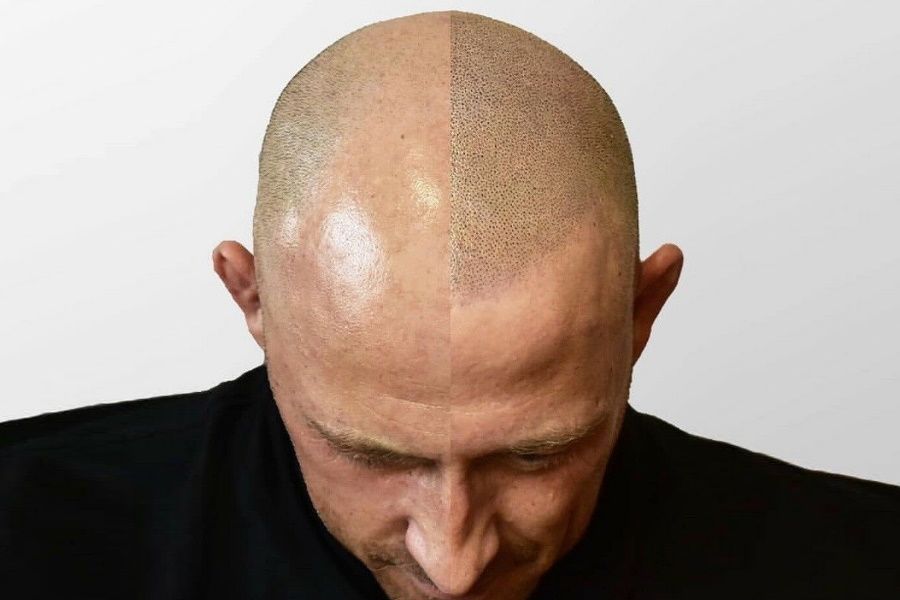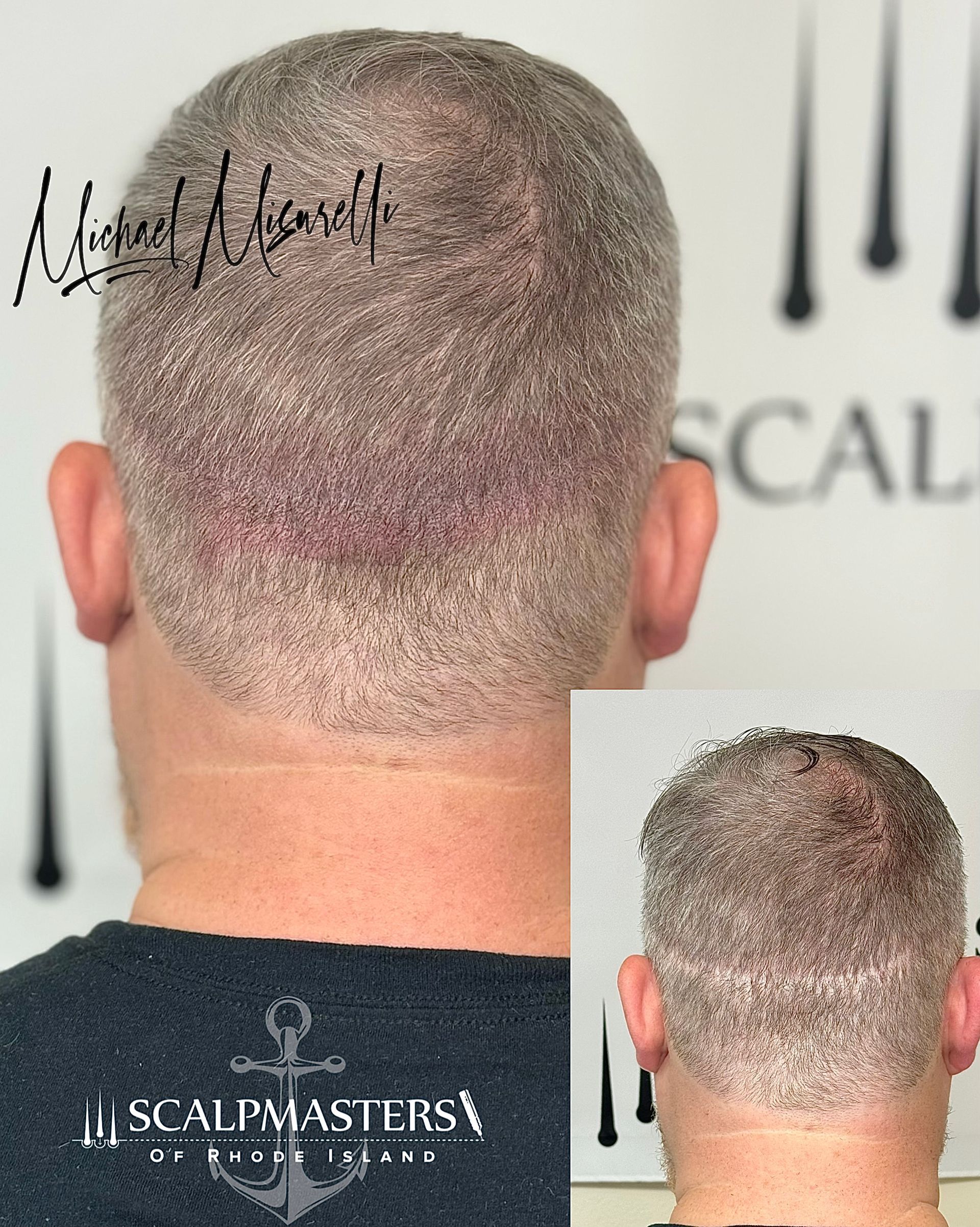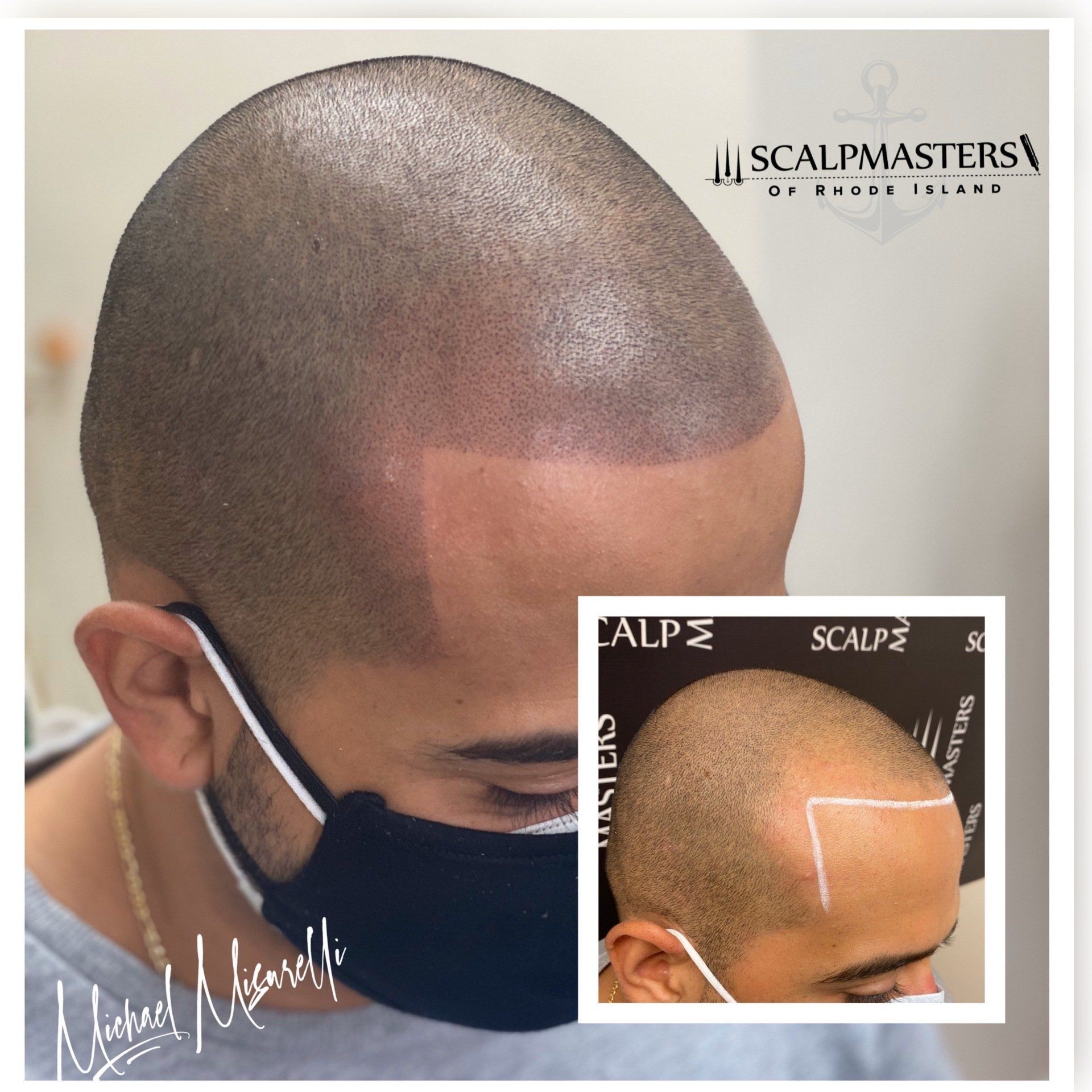Receding Hairline in Men: Expert Insights and Proven Solutions
Are you struggling with a receding hairline? Don't worry; you're not alone. Many men experience this common issue and are searching for practical solutions. In this blog post, we'll dive into the causes of receding hairlines in men and explore proven treatments that can help restore your confidence. We'll also provide expert insights to guide you toward making informed decisions about your hair loss journey. Let's get started!
Understanding Receding Hairline in Men
Receding hairline in men, also known as frontal fibrosing alopecia or androgenetic alopecia (AGA), is primarily caused by genetic factors. This condition progresses through distinct stages, starting with hair thinning at the temples and eventually leading to a receded hairline. Although it can impact self-esteem and confidence, practical approaches are available for treating receding hairlines, such as scalp micropigmentation or consulting a dermatologist for other solutions.
What Causes Receding Hairline?
Genetics and hereditary factors are significant in causing receding hairline, with conditions such as androgenetic alopecia (AGA) being the most common culprit. Hormonal imbalances, specifically increased dihydrotestosterone (DHT) levels, can also contribute to hair loss and thinning in the frontal area. Age-related factors like natural hair thinning and loss can also contribute to developing a receding hairline. Consulting with a dermatologist is crucial for an accurate diagnosis and personalized approach to managing receding hairline caused by genetic or hormonal factors such as AGA or frontal fibrosing alopecia.
Stages of Receding Hairline
Stage 1: In the initial stage of receding hairline, there is a minimal recession at the temples. This may be characterized by a slight thinning or loss of hair in this area. The condition, known as androgenetic alopecia (AGA) or male pattern baldness, is often genetic.
Stage 2: Involves further temple recession with a slight M-shaped pattern as the hairline recurses. The corners of the forehead may show more noticeable signs of hair loss. AGA is typically caused by hormones and genetics working together.
Stage 3: Progressing to stage 3, the M-shaped pattern deepens and becomes more prominent. Hair loss becomes increasingly noticeable around the temples and frontal areas of the scalp. This could indicate frontal fibrosing alopecia (FFA), a form of scarring alopecia that primarily affects women but can also occur in men.
It's essential to consult with a dermatologist or specialist who can provide personalized guidance on approaching your specific type and stage of receding hairline for appropriate treatment options and advice tailored specifically for you.
Common Signs and Symptoms
Thinning hair around the temples or forehead may be one of the common signs and symptoms of receding hairline in men. This can be caused by genetic factors, such as androgenetic alopecia (AGA). Another sign to look out for is the formation of a 'Widow's peak' or an M-shaped hairline, which is often associated with AGA or frontal fibrosing alopecia. Additionally, men experiencing excessive shedding or a gradual reduction in hair density should consult a dermatologist to determine if they are dealing with alopecia.
Impact on Self-esteem and Confidence
Negative emotions like embarrassment, anxiety, or low self-esteem are typical responses to a receding hairline. Men may feel self-conscious and suffer from impaired social interactions due to appearance. This lack of confidence in personal appearance can significantly impact overall self-esteem.
- Negative emotions such as embarrassment and anxiety
- Lack of confidence in personal appearance
- Impaired social interactions due to self-consciousness
Proven Solutions for Receding Hairline
Scalp micropigmentation (SMP) is a proven solution for receding hairline in men. This procedure involves the application of pigments to the scalp, creating the illusion of a full head of hair and camouflaging areas with thinning or no hair. With over 20 years of experience, ScalpMasters RI offers precise and natural-looking SMP procedures that can significantly improve the appearance of a receding hairline.
Hair transplantation is another effective solution for men with receding hairlines. This surgical procedure involves extracting healthy hair follicles from donor areas and transplanting them into balding or thinning areas on the scalp. Hair transplantation provides long-lasting results, restoring confidence and natural-looking hair growth in individuals experiencing receding hairlines.
Scalp Micropigmentation (SMP)
Scalp Micropigmentation (SMP) can create the illusion of a fuller hairline by depositing pigments into the scalp, replicating the look of natural hair follicles. The procedure involves using a specialized micro-needle to tattoo tiny dots on the scalp, resulting in a natural-looking and defined hairline. After SMP, individuals can expect minimal discomfort during and after the procedure, with most experiencing slight redness and tenderness that subsides within a few days.
Benefits of SMP include an enhanced appearance of density in areas with thinning or receding hairlines, improved confidence and self-esteem, and low maintenance compared to other solutions like wigs or constant styling. However, potential risks involve allergic reactions to pigments used during the procedure or dissatisfaction with the final result requiring touch-ups or corrective procedures.
Hair Transplantation
Different types of hair transplant procedures available:
- Follicular Unit Extraction (FUE): Individual hair follicles are harvested and transplanted.
- Follicular Unit Transplantation (FUT): A strip of the scalp is removed and dissected into individual follicular units for transplantation.
Factors to consider before opting for a hair transplant:
- The severity of hair loss
- Overall health and medical history
- Cost and time commitment
Recovery process and expected results:
- The initial recovery typically lasts about 1 to 2 weeks, with most patients able to resume normal activities.
- Full results may take several months as new hair growth gradually appears.
Medication and Topical Treatments
Popular medications for treating receding hairline in men include minoxidil and finasteride. Minoxidil is a topical treatment that stimulates hair growth, while finasteride is an oral medication that blocks the hormone responsible for shrinking hair follicles. However, both medications can have side effects such as scalp irritation or sexual dysfunction. It's essential to consult with a healthcare professional before starting any medication and follow their recommendations on managing these potential side effects. Alternatively, some men may opt for alternative topical treatments like minoxidil or finasteride to address their receding hairline.
Hairstyles for Receding Hairline
Best hairstyles that minimize the appearance of receding hairline: Opt for shorter cuts like buzz cuts or crew cuts to create the illusion of thicker hair and draw attention away from the receding areas.
How to style your existing hair to cover up thinning areas: Experiment with different styles, such as a comb-over, where you sweep your longer hair over the balding spots. You can also try using volumizing products and blow-drying your hair in a forward motion to add lift and camouflage thinning areas.
Trendy haircut options suitable for men with receding hairlines: Embrace a modern look with a textured crop cut, which adds dimension and volume while keeping the length manageable. Another smart option is an undercut hairstyle, where you keep the sides short while leaving more length on top for styling versatility.
Lifestyle Changes for Hair Health
The impact of diet on overall hair health cannot be underestimated. Incorporating nutrient-rich foods like fruits, vegetables, lean proteins, and healthy fats into your daily meals can promote more robust and healthier hair growth.
Effective stress management techniques are crucial to prevent further hair loss. Practicing relaxation activities such as meditation, deep breathing exercises, or engaging in hobbies can help reduce stress levels that contribute to hair thinning.
Regular exercise plays a vital role in promoting healthy scalp circulation. Cardiovascular activities like jogging or cycling increase blood flow to the scalp, delivering oxygen and nutrients essential for maintaining strong and vibrant hair follicles.
Expert Insights on Receding Hairline
Consulting a hair loss specialist is crucial when dealing with a receding hairline. These experts have the knowledge and experience to assess your situation and recommend the most effective treatments, such as scalp micropigmentation. By seeking professional advice, you can make informed decisions about addressing your receding hairline and regain confidence in your appearance.
Understanding the long-term outlook of a receding hairline is essential for managing expectations. While various treatment options are available, it's essential to recognize that not all solutions provide permanent results. Hair loss may continue over time, requiring ongoing maintenance or additional treatments. Discussing the long-term implications with a specialist allows you to develop realistic expectations and choose an approach that aligns with your goals and lifestyle.
Consulting a Hair Loss Specialist
Benefits of seeking professional advice: When dealing with a receding hairline, it is essential to seek professional advice from a hair loss specialist. They have the expertise and knowledge to assess your situation and provide personalized treatment options. By consulting a specialist, you can benefit from their experience in diagnosing the underlying cause of your hair loss and receive guidance on the most effective solutions.
Finding the right hair loss specialist: Finding the right hair loss specialist is crucial for addressing your receding hairline effectively. Look for specialists with experience treating male pattern baldness or receding hairlines specifically. Research their qualifications, reviews, and before-and-after photos to gauge their expertise and track record. Additionally, consider scheduling consultations with multiple specialists to find one who understands your concerns and offers suitable treatment options.
Questions to ask during the consultation: During your consultation with a hair loss specialist, it's essential to ask relevant questions to help you make informed decisions about your treatment plan. Inquire about their experience treating receding hairlines and what results you can expect from different treatments. Discuss any potential side effects or risks associated with each specialist's option. Moreover, inquire about post-treatment care instructions and long-term maintenance requirements for sustaining optimal results.
Understanding the Long-term Outlook
Causes and progression of receding hairline in men:
Genetic factors and hormonal changes primarily cause receding hairline in men. The hormone DHT (dihydrotestosterone) plays a significant role in shrinking the hair follicles, leading to a receding hairline. As time passes, the receding pattern progresses from mild temple recession to more extensive thinning on the crown area.
Identifying patterns and stages of hair loss:
Understanding the different patterns and stages of hair loss is crucial for effective treatment planning. Men typically experience a gradual recession at the temples, forming an "M" shape or widow's peak. This can progress into further thinning on the vertex or crown area. Identifying these patterns allows for personalized solutions tailored to each individual's unique situation.
Genetic factors and predisposition:
Genetic factors significantly determine an individual's susceptibility to male pattern baldness, including receding hairlines. If there is a family history of male pattern baldness, it increases the likelihood of developing this condition. However, it's important to note that not all individuals with genetic predispositions will experience severe or rapid receding hairlines; lifestyle choices and other environmental factors can also influence its progression.
Managing Expectations
1. Realistic goals for treating a receding hairline:
When considering treatment options for a receding hairline, it is essential to set realistic expectations. While scalp micropigmentation can effectively camouflage the appearance of thinning hair and create the illusion of fuller coverage, it is not a permanent solution to regrow lost hair. Understanding that SMP provides cosmetic enhancement rather than actual regrowth will help manage expectations and ensure satisfaction with the results.
2. Different treatment options available:
Men experiencing a receding hairline have various treatment options at their disposal. Scalp micropigmentation offers an innovative solution by utilizing specialized pigments to replicate the look of natural hair follicles on the scalp. Other alternatives include medications like minoxidil or finasteride, which may slow down further hair loss but do not restore lost volume as significantly as SMP.
3. Maintenance routines for preserving existing hair:
In addition to exploring treatments for addressing a receding hairline, it is essential to implement maintenance routines that preserve existing strands. This includes gentle shampooing and conditioning techniques using products specifically for thinning or fine-haired individuals. Regularly massaging the scalp stimulates blood flow and promotes healthy growth while avoiding excessive heat styling tools can prevent damage and breakage.
Say Goodbye to Receding Hairlines: How Scalp Micropigmentation Can Restore Your Confidence
ScalpMasters RI is New England's premier Scalp micropigmentation clinic, offering state-of-the-art procedures to restore confidence and transform appearance. With over 20 years of experience, our highly skilled technicians specialize in providing the most precise and natural-looking SMP treatments on the market. Using advanced techniques and equipment, we can create the illusion of a full head of hair by carefully applying pigments to the scalp, replicating the look of natural hair follicles. Whether you have a receding hairline, thinning hair, or even complete hair loss, our scalp micropigmentation procedures can give you the appearance of a full head of hair, boosting your self-esteem and allowing you to embrace a confident and stylish look again. So say goodbye to receding hairlines and hello to a new you with ScalpMasters RI.
Frequently Asked Questions About Receding Hairlines In Men
-
How can I slow down or prevent a receding hairline?
A receding hairline can be a distressing experience for many men. Fortunately, you can take steps to slow down or prevent the progression of a receding hairline. Here are a few strategies to consider:
1. Adopt a healthy lifestyle: Maintaining a healthy lifestyle can positively impact your hair health.
2. Gentle hair care routine: Avoid aggressive brushing and styling techniques that can put stress on your hair follicles.
3. Avoid tight hairstyles: Pulling your hair back tightly or wearing hairstyles that put constant tension on your hairline can lead to hair loss.
4. Protect your hair from the sun: Prolonged exposure to the sun can damage and contribute to hair loss.
5. Minimize stress: Chronic stress has been linked to hair loss. Find healthy ways to manage stress, such as practicing mindfulness techniques, exercising, or engaging in hobbies you enjoy.
-
Are there any treatments for a receding hairline in men?
Yes, there are several treatments available for a receding hairline. One of the most influential and popular options is scalp micropigmentation (SMP). SMP is a non-surgical procedure that uses micro-needles to deposit tiny dots of pigment into the scalp, creating the appearance of a fuller, thicker hairline. This technique can be tailored to match your natural hair color and closely mimic the look of actual hair follicles.
-
Can stress or anxiety cause a receding hairline in men?
While stress and anxiety can undoubtedly contribute to various health issues, including hair loss, they do not directly cause a receding hairline. Genetic factors and hormonal changes primarily cause receding hairlines. However, stress and anxiety can exacerbate existing hair loss conditions, such as male pattern baldness, by triggering or accelerating hair-shedding.
When we experience stress or anxiety, our bodies release cortisol. Elevated cortisol levels can disrupt the normal hair growth cycle, leading to an increased rate of hair loss. Additionally, stress can cause inflammation in the scalp, further damaging hair follicles and inhibiting hair growth.
It is important to note that while stress may not cause a receding hairline directly, it can worsen the condition. Managing stress and practicing self-care techniques such as exercise, meditation, and seeking support from loved ones or professionals can help mitigate the effects of stress-related hair loss.
-
What are the risks associated with a receding hairline?
A receding hairline, also known as male pattern baldness, can cause concern for many men. While it is a natural part of aging, it can have certain risks. Here are some of the risks that men with a receding hairline may face:
1. Psychological Impact: Losing hair can significantly impact a person's self-esteem and confidence.
2. Sunburn and Skin Damage: Without hair protection, the scalp is more exposed to harmful UV rays from the sun.
3. Scalp Infections: A receding hairline can make the scalp more vulnerable to infections.
4. Limited Hairstyle Options: As the hairline recedes, it can limit the hairstyle options for men. They may find it challenging to
Learn More
What's New
Latest Hair Loss Solutions & Guides

Michael Misurelli, the founder has over 25 years of experience working as a licensed barber and is both certified and experienced to perform and perfect Scalp Micropigmentation.
Contact Information
Mon - Sun: 9:00am - 7:00pm
845 Oaklawn Ave Unit 103, Cranston, RI 02920
Resources
Locations
All Rights Reserved | Scalpmasters RI.



